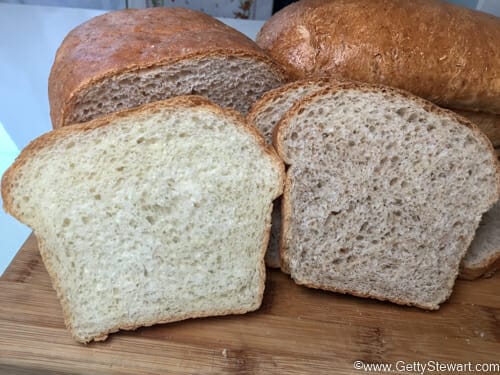Whole Wheat Does Not Mean Whole Grain in Canada
Is 100% Whole Wheat Bread Whole Grain?
Not necessarily. In Canada, bread made with 100% whole wheat flour is not whole grain bread.
This is because Canadian whole wheat flour, unless otherwise specified, is missing parts of the whole grain. You see, in Canada, when wheat is processed into flour, the various parts of the kernel are separated. To make whole wheat flour, some of the bran and germ are added back – but not all. Canada’s Food and Drug Regulation permits up to 5% of the kernel to be removed. Typically, it is the nutrient rich bran and germ that are removed as a way to reduce rancidity and increase shelf life.
According to the American Association for Cereal Chemists, the internationally recognized leader in this area, whole grain is defined as “consisting of intact, ground, cracked or flaked grain whose principal components – the endosperm, germ and bran are present in the same relative proportions as they exist in intact grain.” Canadian whole wheat flour does not meet that criteria, therefore any product made primarily from whole wheat flour cannot be considered whole grain.
Notice I specifically said Canadian whole wheat; flour in the US, UK and Europe is actually 100% whole grain, therefore their 100% whole wheat bread is whole grain bread. Crazy, eh?!

What’s the Benefit of Whole Grain?
Whole grains are higher in fibre, vitamins and minerals than refined or enriched grain products. And according to Registered Dietitians with EatRightOntario, research shows that people who eat more whole grains may have a lower risk of heart disease, stroke, diabetes, and some cancers.
Choosing whole grain products more often is a good choice.
What does this mean?
To ensure you’re getting whole grain bread, pasta or other goods read the ingredient label and look for the following as one of the first ingredients listed:
What to Look for When Buying Bread
In the article, Leslie Beck recommends you look for the following when buying bread:
- 100% whole grain
- 2 g of fibre/30 g slice of bread or 3 g of fibre/45 g slice of bread
- < 200 mg of sodium per slice
- as little sugar as possible
When making bread at home, use as much whole grain flour as your family will tolerate. Gradually increase the amount of whole grain flour until you’ve fallen head over heels in love with the texture and flavor of whole grain bread.
You may need to buy whole grain flour from a bulk store or direct from a local supplier. Another option is to use regular store bought flour and add bran and wheat germ into your dough. In an article on Home&Family.net, Fellow Professional Home Economist, Jennifer Dyck recommends adding 1 tablespoon of wheat germ for every cup of whole wheat flour you use.
Does any of this information surprise you? Will this information change your bread purchasing/making?
Sign up to get articles by Getty delivered to your inbox. You’ll get recipes, practical tips and great food information like this. Getty is a Professional Home Economist, speaker and writer putting good food on tables and agendas. She is the author of Manitoba’s best-selling Prairie Fruit Cookbook, Founder of Fruit Share, a mom and veggie gardener.


